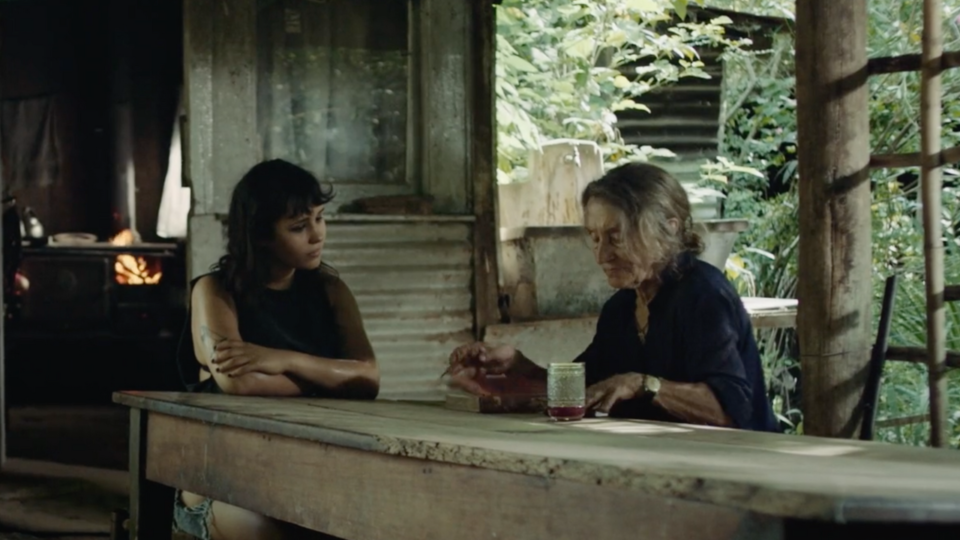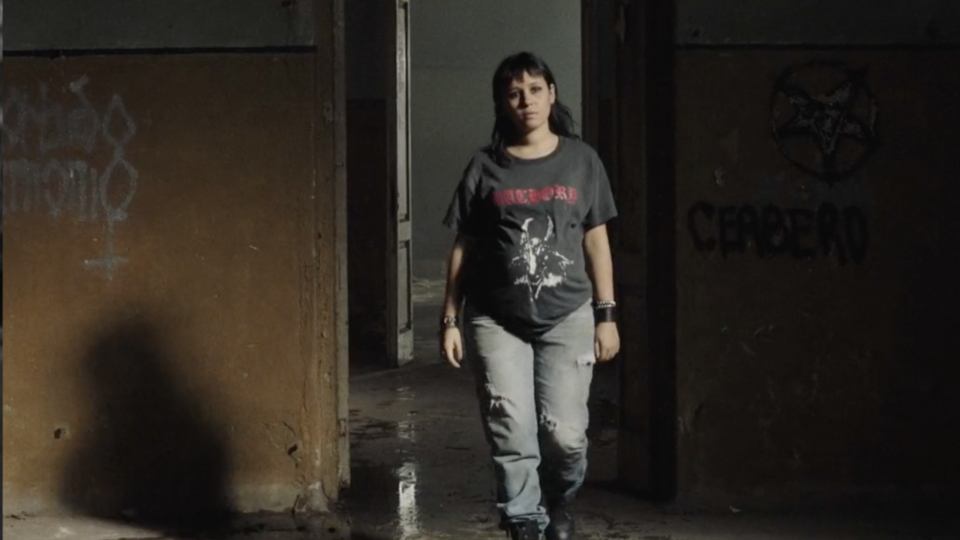‘Welcome to Hell’: An Argentinian Take On Heavy Metal Horror [Horror En Español]

Welcome to Hell, written and directed by Jimena Monteoliva, is a horror film that focuses on mood and relationships above anything else. Monteoliva utilizes the Black Metal community, to not just set the aesthetic and tone for her film, but follows the sub-genres admiration for atmospheric story-telling. With the two cinematographers, Federico Bracken and Georgina Pretto, and their excellent chiaroscuro lighting technique, Welcome to Hell becomes an Argentinian atmospheric Black Metal delight.
The film follows Lucía (Constanza Cardillo) as she’s pregnant and resides with her mute Abuela (Marta Lubos). Through a nonlinear narrative, we see Lucía meet her boyfriend Christian, (Demián Salomón) during a Black Metal basement show. He’s the frontman of an unnamed band and Lucía and Christian bond over the music. Through the consistent time jumps, we witness Lucía and Christian fall in and out of a relationship. Unfortunately for Lucía, the relationship turns abusive. She goes into hiding as Christian has plans to sacrifice her to a demonic entity.
While the film travels back and forth in time, there are two main distinguishers to tell apart the present and the past. Lucía’s pregnant belly is the indicator of the present. But on top of that, the mise en scène plays a key factor. The cinematographers’ skills shine as we see the drastic differences between Lucía living with her Abuela in the present and her time with Christian in the past.
When Lucía is in hiding and living with her Abuela in a secluded cabin in the forest, the atmosphere is vibrant and free. There’s clear sunlight in every room. The natural setting fuses with the interior of the cabin. Birds are constantly chirping signifying Lucía freedom within the forest. This is also where we see the relationship between Lucía and Abuela. With Abuela being mute, Lucía does the majority of the talking and the instances Abuela does communicate are through quotes she leaves for Lucía laying around the house.

Now when we compare these sequences in the cabin with Lucía’s time with Christian, the distinctions become abundantly clear. When Lucía and Christian first lock eyes, he is performing in a music venue with his Black Metal band. The scene is chaotic and claustrophobic. As he headbangs to the fast-paced music, the artificial strobing lights create urgency and anxiety especially after just witnessing Lucía spending time with Abuela at the cabin. While the strobing lights stop after the show, the lighting is still adamant to the story.
Welcome to Hell time jumps to Lucía sitting on a couch next to Christian in an abandoned house. While there are open windows where the sunlight sneaks in, the primary lighting is through a fixture. The lamp is dull and shadows overtake the scenery. The low lighting enhances the cement walls with decaying green paint. A sense of uneasiness lingers in the background. In the following scene, Lucía and Christian are in a basement. The lighting is primarily through candlelight. The green peeling walls switch to an all-white decaying cement wall. The room is filled with debris scattered onto the floor.
The sound design is also imperative to the scenes with Christian. While the silence between Lucía and Abuela is comforting, the silence is oppressive between Lucía and Christian. Lucía attempts to break the silence with playful banter but Christian retaliates with abuse. The scoreless scene with the deafening foley makes this a hard watch. Claustrophobia begins to settle once again. Lucía is powerless while Christian begins with his destructive tendencies. What first begins with his abuse towards her, he allows her to reciprocate. This leads to a twisted relationship between the two with Lucía conceiving a baby by the end of the night.
Once Lucía discovers Christian’s and the band’s homicidal manner, Lucía escapes their grasp. This leads the story to the present with pregnant Lucía hiding in the forest with Abuela. As Welcome to Hell reaches the final act we finally see the Black Metal band away from the intimidating abandoned building. But even in the wild, Monteoliva is able to recreate the menacing force radiating from Christian. The oppressive presence is produced with the framing of the shadows. As he holds a torch high in the air, the flames produce a flickering red light just like when Lucía first met Christian. Only this time, the threatening lighting has now infiltrated Lucía’s safe space.
Monteoliva titles this section “Walpulgris”. According to Britannica, Walpulgris Night is a traditional European and Scandinavian holiday. Festive activities include singing folk songs and lighting bonfires. The origins of the holiday can be traced back to pagan fertility rites. But in Welcome to Hell, the night is anything but a celebration. After the home invasion sequence, the band successfully kidnaps Lucía. She is placed onto an inverted cross and prepared for the sacrifice. The flickering flame coming from a burning trash can, which can be seen as a bonfire, now feels like an omnipotent force as it shines on Christian’s corpse paint. But this is where Monteoliva flips the script on Christian.
Emerging from the fire is Lilith, the demonic woman figure from Jewish folklore. Her presence is powerful. The lighting surrounding Christian that was used to intimidate during the home invasion sequence is now transferred to Lilith. The flickering flame now consoles Lucía. As the all-powerful being that Lilith is, she disposes of the remaining band members but spares Lucía. Her family is officially free from harm and her secluded cabin is a secret once again.

Welcome to Hell relies heavily on lighting to set the tone of the scene, from the oppressive darkness of Lucía’s past to the calm light in her present. But the significance of lighting doesn’t end there. If you look up the English translation of the name Lucía, we get “light”. This is just one of the many examples of how Monteoliva leaves plenty of subtle and obvious indicators of the importance of light and shadows in Welcome to Hell. Through the lighting and set pieces, Monteolvia creates an atmospheric genre film that must not go unseen.
Categorized:Editorials Horror En Espanol News

